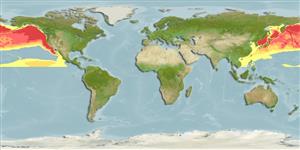Common names from other countries
Environment: milieu / climate zone / depth range / distribution range
Ecologie
Pelagisch; standvastig (Ref. 75906). Subtropical; 90°N - 10°N, 180°W - 180°E
Pacific Ocean and the Arctic. Subtropical to polar.
Length at first maturity / Size / Gewicht / Leeftijd
Maturity: Lm ?, range 1,000 - 1030 cm Max length : 1,190 cm TL mannelijk/geslacht niet bekend; (Ref. 1394); 1280 cm TL (female); Maximaal gepubliceerd gewicht: 12.0 t (Ref. 1394)
Found close to shore where deep water approaches the coast; primary habitat appear to be over or near the continental slope and oceanic seamounts. Feeds mainly on deep-water and bottom-dwelling fish, cephalopods, and crustaceans (Ref. 1394).
Jefferson, T.A., S. Leatherwood and M.A. Webber. 1993. (Ref. 1394)
Status op de Rode Lijst van het IUCN (Ref. 130435)
Status bij CITES (Ref. 108899)
Gebruik door de mens
Visserij: commercieel
FAO - Visserij: landings, soortsprofiel | FishSource | Sea Around Us
Tools
Internet-bronnen
Estimates based on models
Preferred temperature
(Ref.
115969): 0.2 - 2.4, mean 1.6 (based on 2054 cells).
Kwetsbaarheid
Very high vulnerability (87 of 100).
Prijsklasse
Unknown.
